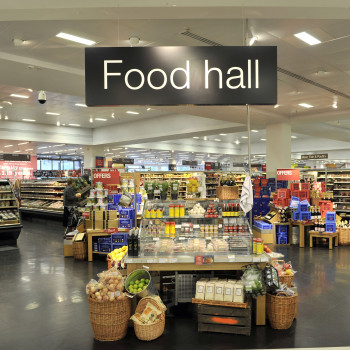M&S half-year results show food sales up 14.7%
10 November 2023
M&S has recorded a profit before tax and adjusting items of £360.2m – up from £205.5m in 2022/23, according to the retailer’s half year results for the 26 weeks ended 30 September 2023.
Statutory profit before tax stood at £325.6m (up from £208.5m in 2022/23.) Meanwhile, food sales were up 14.7%; with adjusted operating profit of £164.9m (2022/23: £71.8m) and margin of 4.3%.
With food sales growing by 14.7% and like-for-like sales up 11.7%, M&S highlighted that this outperformed all mainline UK grocers on volume as customer numbers increased.
According to the retailer, growth was underpinned by further investment in trusted value, category resets in basket building areas such as grocery and homecare, and ongoing quality upgrades of products in key customer missions including ‘Dinner for tonight’ and ‘Events’.
Adjusted operating margin recovered to 4.3% from 2.2% last year, (2021/22: 4.6%). This was driven by growth in volume and market share, manufacturing efficiencies and the benefits of the Gist acquisition completed last year of over £30m.
Analysis
Nick Drewe, retail expert and founder of online discounts platform, Wethrift, provides insight into why M&S’s strategy has enabled such a successful six months, and how the retailer is closing the gap between more premium and budget supermarkets.
“This week, M&S announced a 56% increase in pre-tax profit over the last six months, driven by an increase in food sales. For many, this may come as a surprise due to the ongoing economic certainty and volatile market.
“Given the current challenges being faced by all retailers, this makes the recent successes of M&S’s revamp particularly impressive. The market has faced an extremely challenging year, with the continuing cost of living crisis and rising inflation putting a significant strain on consumer spending.
“In terms of food shopping, M&S faced the very prominent risk of a large portion of loyal customers considering switching to more budget-friendly competitors such as Aldi and Lidl. Fortunately, M&S acted smart and fast, reducing the overall prices of food items in reaction to tightened consumer spending, enabling them to remain competitive as part of the retailer’s wider revamp.
“A main driver of success for M&S is that they are able to capitalise on shifting consumer behaviours, and the focus on quality when it comes to food. Rather than switching to budget brands during the cost of living crisis, many consumers are switching up their cooking habits, rather than just focusing on cheaper options.
“Shoppers are looking to save on food costs by simply cooking smarter, and making more conscious decisions when it comes to their shopping and eating habits. For example, still purchasing quality food products, but using them for meal prepping, batch cooking and more consciously planning their meal plan to ensure they are making the most of high-quality groceries.
“Fortunately, M&S benefits from being positioned in the minds of the consumer as a high-quality brand. By reducing the pricing of their food items, M&S have been able to close the gap between their pricing and that of more budget competitors like Aldi, Lidl and Asda, but are still able to retain their premium positioning, giving them the competitive edge.
“The retailer is also benefiting from early Christmas food shopping, as shoppers put more focus on shopping premium and high-quality retailers for this year’s Christmas dinner. This will only strengthen M&S’s profit margins as we approach the festive season.”
Excellent first half, but tone of caution may disappoint
Charlie Huggins, manager of the Quality Shares Portfolio at Wealth Club, has also analysed M&S’s latest results:
“In a difficult trading environment M&S has delivered excellent results, with notable progress in Food and Clothing and Home, and both businesses outperforming the market. With momentum having continued into October, the turnaround plan to revitalise the brand and reignite growth is well on track and the group can look forward to the Christmas period with confidence.
“The Clothing and Home division has been a problem child for M&S for many years. The new strategy, launched last year, aims to improve brand perception and designs, reduce discounting and improve the online offering, while taking a knife to costs and instilling a more entrepreneurial culture. Early signs are this plan is resonating with consumers.
“However, pressure on the UK consumer could intensify heading into 2024 as the impact of higher interest rates really starts to bite. This, combined with tougher comparatives means M&S is striking a tone of caution looking ahead to the second half. This may disappoint investors.
“Overall, M&S is delivering strongly on the things it can control and seems to be in a much better place now than it was a few years ago. However, it isn’t fully in charge of its own destiny and is heavily dependent on consumer confidence, where uncertainties still abound.”




 Print
Print





Fans 0
Followers